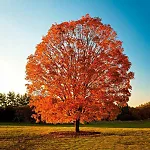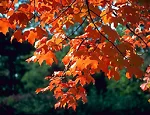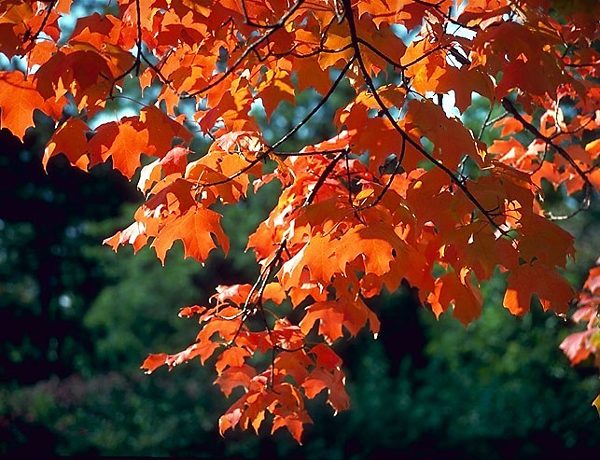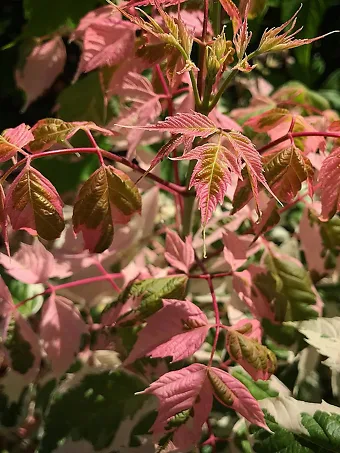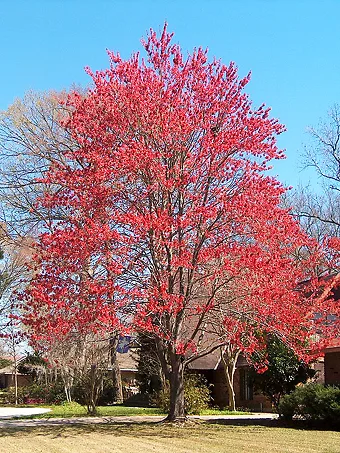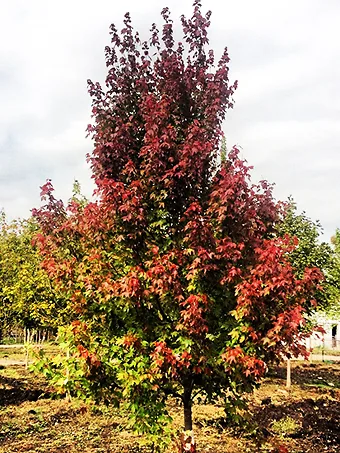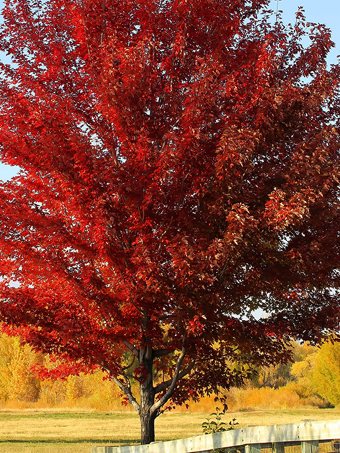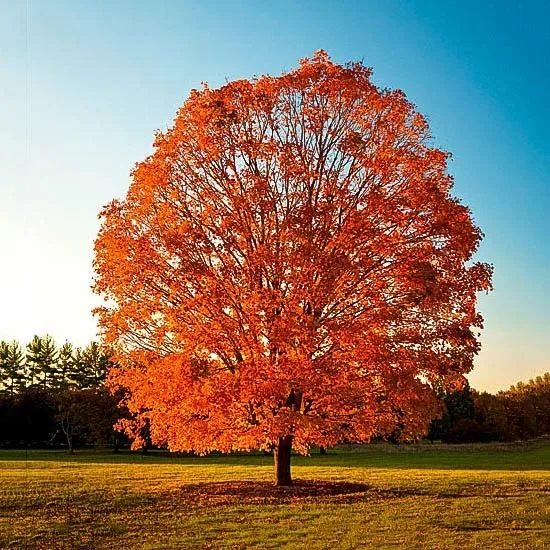
Sugar Maple
Acer saccharumView more from Maple Trees
Sugar Maple
Acer saccharum
30 day - ARRIVE AND THRIVE™ guaranteeLearn more


Special Features

Botanical Name
Acer saccharum
Outdoor Growing zone
3-8
Mature Height
55-75
Mature Width
30-50
Sun needs
Full Sun, Partial Sun
Sugar Maple is a native American tree and the source of maple syrup. It makes a wonderful shade-tree and is known mainly for its spectacular fall colors in yellow, gold, orange and red. It is a trouble-free tree that grows at a moderate rate to make a wonderful shade tree, woodland tree or privacy screen.
• Emblem of the fall – the perfect tree
• Best fall color of any tree you can plant
• Perfect shade or privacy tree
• Grow your own maple syrup
• Best tree for shady locations
Sugar Maple will grow in most soils but does not like wet conditions. It also grows well in shade, so if you have large trees on your property already, the Sugar Maple will develop even under the shade of other existing deciduous trees, making it ideal for planting in established gardens. Tough and hardy in the coldest areas, the Sugar Maple has to be the number one choice for that special tree in your front or back yard.
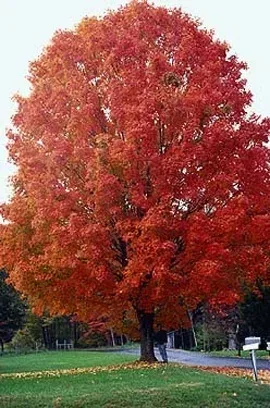
When choosing a shade tree it is good to pick one that does more than just give shade. Fall color is a natural feature of many trees but few are as famous or as glorious as Sugar Maple. Many people travel to New England and Canada every fall to see the brilliant display put on by the forests of sugar maple but you can enjoy that same spectacle in your own garden. If you are looking for a large shade tree that will live for many decades and increase in beauty as it grows, then Sugar Maple is an excellent choice. It can be grown as a specimen tree in a large lawn or planted around your property to give form and height to your garden. It also makes a terrific privacy tree when planted in groups or rows, and it can even be pruned into a hedge.
Growing Sugar Maple Trees
Maple is a tree that will happily grow in shade until it reaches the sunlight above, so it can be planted among other deciduous trees. Perhaps you have some existing old trees on your property. At some time in the future these may become old and need removal. If you have planted Sugar Maples among them, they will have grown and be ready to replace your old trees when that time comes. If you plant your Sugar Maple in the open it will develop a broad, round crown. If planted in the shade of other trees it will be more upright and taller, with a narrower outline. Flowers can be seen in early spring, but these are not conspicuous and look like small green balls on the branches of the tree before the leaves emerge. They develop into the well-known ‘maple keys’ that spin through the air in fall. The bark is brown and as the tree matures it develops vertical ridges and furrows and becomes rougher.
Hardiness
Sugar Maple grows from zone 3 to zone 8, so it is a good choice as a shade tree for gardens in cooler areas. The best fall color develops if you have warm days and cold nights in fall. In warmer areas, although still a good shade tree, fall color will be mostly yellow.
Soil Conditions
Sugar Maples prefer deep, rich soil of a loamy or sandy nature. They will tolerate clay soil if it is well-drained. They will not do well in wet, badly-drained soils or in thin, rocky soils. This tree will do well in urban setting but needs to be located away from highways or areas of pollution. It is not tolerant of road-salt. It will also thrive in rural areas and is an excellent choice for developing natural woodland areas or for large properties.
Growth Rate
Your Sugar Maple tree will grow around one foot per year but may grow a little faster while it is young. If you are planting in a lawn, apply good organic mulch underneath the branch area, but keep the mulch away from the actual trunk. Keep your tree well-watered, especially when young and use a tree fertilizer to keep it growing rapidly and healthily.
Care and Maintenance
No special pruning is required, just remove any crowded branches and leave a few strong, well-spaced branches to make the main framework of your tree. This tree is generally free of major pests or diseases and keeping it growing well with water and nutrients will develop a strong, healthy tree.
Planting Location
When choosing a location for your Sugar Maple allow plenty of room for your tree to develop without becoming a hazard to buildings of power-lines. Allow 30 feet clearance from surrounding buildings. Choose a sunny location, although Sugar Maple will also grow in the shade of other deciduous trees.
A tree for life deserves a little care, so dig a wide, shallow hole about three times the diameter of the pot. Add some organic material like compost, manure or peat-moss and some bone-meal or superphosphate. Before planting your tree, remove it from the pot and with a sharp knife make three or four cuts an inch deep down the sides of the root-ball. This will encourage the roots to spread out rather than growing round the tree and potentially restricting its growth. Place the tree in the centre of the hole, put back most of the soil and firm it down well. Add lots of water and when it has drained away fill in with the rest of the soil. Water your new tree well every week for the first season.
History and Origins of the Sugar Maple
Sugar Maple (Acer saccharum) is a forest tree that can reach 80 feet or more in the wild, but is more likely to be around 40 feet in a garden setting. It is found growing naturally throughout the north-east, as far west as Minnesota and south to Virginia and Tennessee. It has a dense, rounded crown about 30 feet across on a 40 foot tree, reaching 60 feet across on an 80 foot tree.The leaves are the familiar ‘maple-leaf’ form, with 5 lobes and they are about 5 inches or more in size.It is a deciduous tree so it loses its leaves in winter, but not before they turn to beautiful shades of gold, orange and crimson.
Buying Sugar Maples at The Tree Center
Sugar Maple is a distinct species and other types of maples will not have the same fall color and growth habits. Seedling trees are very variable and our trees are grown by grafting stems of selected, improved forms onto seedling roots. This also develops a good trunk structure and ensures that your tree will have top-quality fall color. However, these take longer to produce, so avoid cheaper seedling trees that will only be a disappointment.
We sell only trees that are true to their proper form and we have a wide range of sizes to give you the best plant for your purpose. However, we are constantly renewing our stock so our customers get fresh, healthy plants – so supplies of this tree may be limited.
